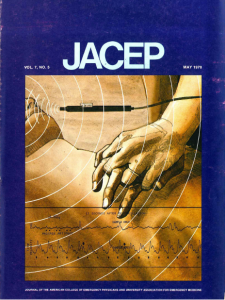 In conjunction with the 50th anniversary of the founding of ACEP, it seems appropriate to look at the 50-year evolution of the assessment and care of chest pain in the emergency department. I have not been around for all 50 years, but I have been an ACEP member since 1975 and have personally experienced the majority of the evolution of chest pain care over that time.
In conjunction with the 50th anniversary of the founding of ACEP, it seems appropriate to look at the 50-year evolution of the assessment and care of chest pain in the emergency department. I have not been around for all 50 years, but I have been an ACEP member since 1975 and have personally experienced the majority of the evolution of chest pain care over that time.
Explore This Issue
ACEP Now: Vol 37 – No 05 – May 2018At an estimated 8 to 10 million visits a year, chest pain remains an everyday complaint in the emergency department and one that is associated with some significant angst on the part of clinicians. Until the recent past, missed myocardial infarction had been the leading cause of malpractice suits and even though the top position is now related to stroke care, the fear of making a mistake in the assessment of chest pain patients remains high. A recent study of closed malpractice claims by The Doctors Company (the largest physician-owned malpractice insurer) found it ranked number two on the list.
It seems the core problem with the assessment of chest pain patients, who largely turn out not to have serious disease, relates to the concept of the “acceptable miss rate.” What percentage of patients with chest pain (or an equivalent) who are discharged after a seemingly benign evaluation will actually have a major adverse cardiac outcome that may have been averted if the patient was admitted? Historically, about 2 percent of patients with an acute myocardial infarction (AMI) or sudden death were mistakenly sent home after an ED visit. Is this percentage still the case? It is hard to conceive of how we could still miss this many, given the current extraordinarily high rate of admissions for chest pain. However, the core issue is, What percentage of misses is U.S. society willing to accept, given it is impossible to get to 0 percent?
Although it is difficult to provide an exact chronology regarding the evolution of the assessment and treatment of chest pain over the last 50 years, there are some general timeframes that can be given. Henceforth, the assumption will be made that the goal of the endeavor is to exclude or make the diagnosis of ischemic chest pain and that all other diagnoses will not be considered.
1968
History and Physical Exam
By far, the emphasis at this early stage in the assessment of chest pain was the importance of the history and, to a lesser extent, the physical exam. Despite all of the advances in ED diagnostic capabilities, obtaining a careful history remains the single most important element in making the diagnosis of acute coronary syndrome (ACS).
Electrocardiograms (ECGs)
Obtaining a 12-lead ECG has been a routine part of the evaluation of potential cardiogenic chest pain. However, in the early days there were no guidelines advising that an ECG be obtained within 10 minutes of arrival, as is currently recommended by the American Heart Association. In addition, there was no computer software, which is routinely available now, to interpret an ECG.
Chest X-Rays
Even 50 years ago, a portable chest X-ray was routinely performed in the assessment of potential cardiogenic chest pain. The machines were big and unwieldy, and the films were just that—sheets of radiographic film that were developed in a dark room using a variety of liquid chemicals. When the films needed to be read immediately, they were often still wet, and the term “wet reading” was commonly used for a stat interpretation.
Cardiac Enzymes
In the late 1960s, the creatinine phosphokinase (CK) enzyme was routinely measured in chest pain patients. This enzyme was found to have a variety of isoforms. Skeletal muscle expresses CK-MM (98 percent) and low levels of CK-MB (1 percent). The heart expresses CK-MM at 70 percent and CK-MB at 25 to 30 percent. A third variety is CK-BB, which is predominantly expressed in the brain and smooth muscle. The overlap between CK-MM and CK-MB allowed for multiple causes of CK elevation to be found (eg, rhabdomyolysis, muscle trauma, myocardial infarction, myositis, and myocarditis). Other causes of CK elevations included hypothyroidism, malignant hyperthermia, and neuroleptic malignant syndrome. In addition, CK elevations could occur in the myopathy associated with use of statins, which were discovered in 1976 and introduced for patient care with lovastatin in 1987. The bottom line: CK-MB elevations were not at all specific for myocardial cell damage, but they remained the standard for assessment until the development of the troponins. Even today, some older clinicians refer to the troponins as “enzymes” when, in fact, they are not, but the term “enzymes” was routinely used to refer to chemicals in the blood that may be elevated in the setting of cardiac cellular injury.
Pages: 1 2 3 | Single Page




No Responses to “The 50-Year Evolution of Acute Coronary Syndrome Care”